Cozy Up to a Bowl of Traditional Irish Dublin Coddle
There’s something truly special about a dish that brings warmth and comfort to the table. This recipe, rooted in history, has been a staple in homes for centuries. Dating back to the late 1700s, it emerged during challenging times, offering nourishment and solace1.
Made with simple yet hearty ingredients like potatoes, onions, rashers, and sausages, this dish is both filling and flavourful2. Whether you prefer the “white” or “brown” method, the process is straightforward, making it accessible for any home cook2.
We’ll guide you through each step, ensuring you can recreate this classic with ease. Perfect for a cosy evening, it’s a celebration of tradition and taste. Let’s explore how to bring this comforting meal to your kitchen.
Understanding the Heritage of Irish Dublin Coddle
Steeped in history, this dish tells a story of resilience and tradition. Originating in the 18th century, it was a staple for working-class families, who relied on simple ingredients like sausages, rashers, and potatoes to create a filling meal3. Its name, derived from the Irish word “caídéal,” reflects the gentle simmering method used to tenderise the meat3.

Over time, this dish became a symbol of resourcefulness and cultural pride. It’s often linked to St Patrick’s Day, where it’s enjoyed as part of festive celebrations3. The addition of herbs like thyme and a rich broth made from chicken stock has enhanced its flavour, making it a beloved dish across generations4.
Historical Roots and Cultural Significance
This dish’s roots lie in the heart of Dublin, where it was a practical solution for families with limited resources. The use of leftover meats and vegetables ensured nothing went to waste3. Its mention in James Joyce’s “Ulysses” highlights its cultural importance, as it was a meal that brought people together3.
A Traditional Meal for Every Irish Home
Today, this dish remains a cherished part of Irish culinary heritage. Whether served with a slice of crusty bread or a pint of Guinness, it continues to warm hearts and homes. Its enduring legacy is a testament to the power of simple, hearty food3.
Essential Ingredients for a Flavourful Coddle
The secret to a truly comforting dish lies in its ingredients. For this recipe, quality is key. Each component plays a vital role in creating a rich, savoury base that’s both hearty and satisfying.

Bacon, Sausages, and Potatoes
Thick-cut bacon is a must for this dish. Its robust flavour and texture ensure it doesn’t dry out during cooking5. Pair it with high-quality pork sausages, which add depth and juiciness to every bite6.
Potatoes are the backbone of this recipe. Waxy varieties like Maris Piper or Rooster are ideal, as they hold their shape well5. Peeled and cut into bite-sized pieces, they absorb the flavours of the broth beautifully6.
Herbs, Spices, and That Special Stout
Fresh parsley and minced garlic bring a burst of freshness to the dish. Bay leaves and thyme add an earthy aroma that complements the richness of the meat6.
A bottle of Guinness stout is the secret ingredient that ties everything together. Its malty notes enhance the savoury base, creating a truly unforgettable flavour6.
- Bacon: Thick-cut for maximum flavour and texture.
- Sausages: High-quality pork sausages for juiciness.
- Potatoes: Waxy varieties to maintain texture.
- Herbs: Parsley, garlic, bay leaves, and thyme for freshness and aroma.
- Stout: Guinness to elevate the savoury base.
Using locally sourced, fresh ingredients ensures authenticity and enhances the overall taste. Each element works in harmony to create a dish that’s both comforting and deeply satisfying.
Step-by-Step Cooking Techniques
Cooking this dish is a journey of simplicity and flavour. To achieve the perfect balance, we’ll guide you through each step, ensuring every layer of the dish is infused with rich, savoury goodness.
Prepping and Layering Your Ingredients
Start by rendering the fat from thick-cut bacon in a large pot. This step not only adds depth to the dish but also ensures the bacon remains tender7. Next, brown the sausages to lock in their juices, creating a robust base for the recipe8.
Layer the ingredients carefully. Begin with a base of onions and garlic, followed by the browned sausages and bacon. Add potatoes and carrots, ensuring each layer is evenly distributed9. This method allows the flavours to meld beautifully during cooking.
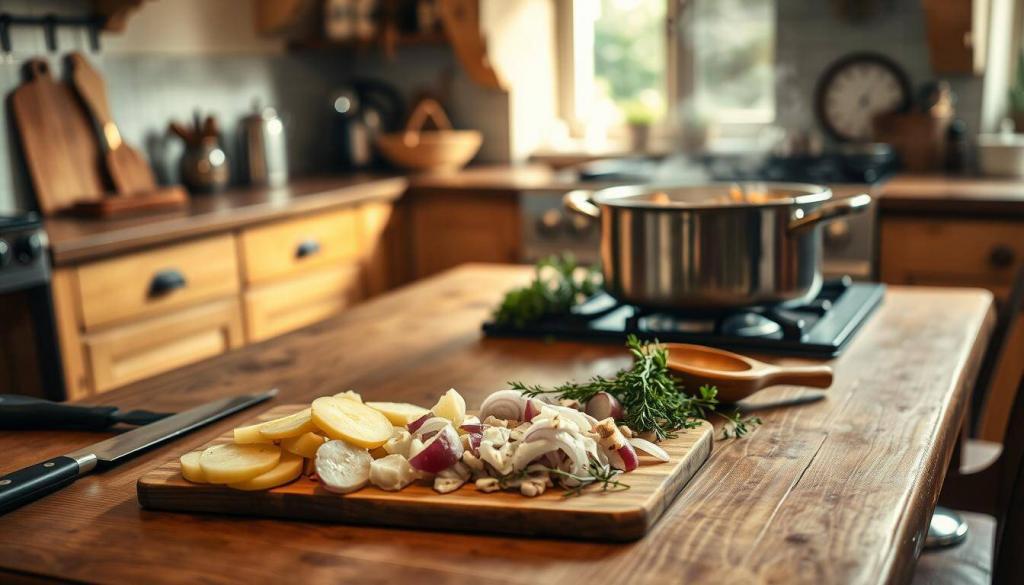
Cooking in a Dutch Oven: Oven or Stovetop?
Using a Dutch oven is the ideal way to cook this dish. On the stovetop, bring the ingredients to a gentle simmer over low heat. This method ensures the potatoes remain tender while the gravy thickens7.
Alternatively, cooking in the oven at 180°C (350°F) allows for even heat distribution. Cover the pot and let it cook for 1.5 to 2 hours, checking occasionally to ensure the potatoes are soft8. Both methods yield a rich, flavourful dish, but the oven method offers a hands-off approach.
Here’s a quick comparison:
- Stovetop: Requires monitoring to maintain a gentle simmer.
- Oven: Ensures even cooking with minimal effort.
Whichever method you choose, the result is a comforting meal that’s perfect for any occasion.
Mastering the Art of Layering Flavours
Creating a dish with depth requires more than just mixing ingredients—it’s about layering flavours thoughtfully. Each component must be added at the right time and in the right order to build a harmonious stew. Let’s explore the techniques that elevate this dish from simple to extraordinary.
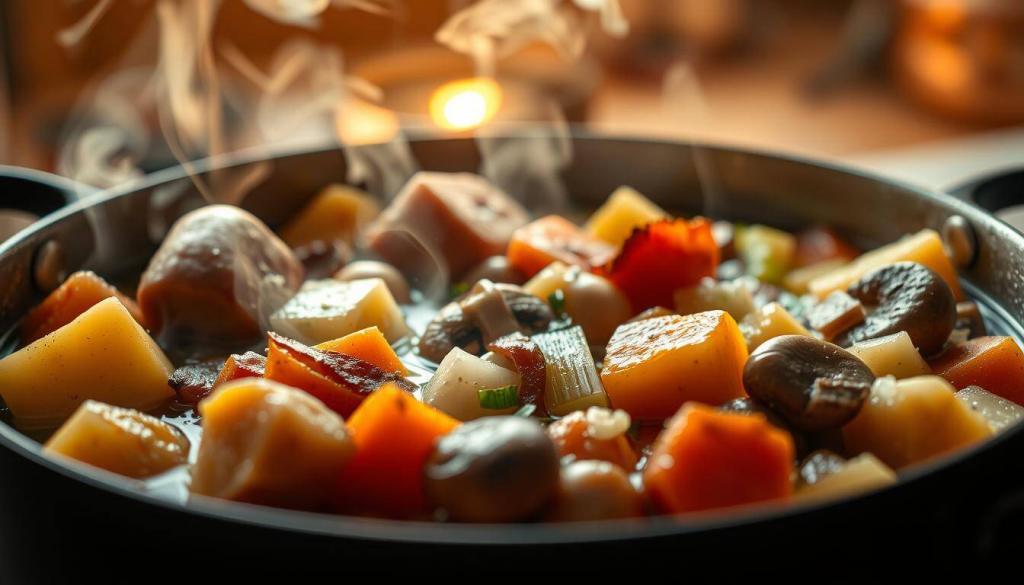
Building a Robust Gravy with Flour and Guinness
Start by browning the bacon to render its fat, which carries immense flavour. This fat forms the base of your gravy. Sprinkle a tablespoon of flour into the pot, stirring constantly to create a roux. This thickens the stew and adds richness10.
Next, pour in a splash of Guinness stout. Its malty notes enhance the savoury base, creating a complex and robust gravy. Let it simmer for about 10 minutes to allow the flavours to meld10.
Integrating Onions, Garlic, and Parsley Perfectly
Onions and garlic are essential aromatics that form the foundation of your stew. Sauté them in the rendered fat until they’re soft and fragrant. This step releases their natural sweetness, balancing the dish’s richness11.
Fresh parsley, added towards the end, brings a burst of freshness. Its bright flavour cuts through the heaviness of the stew, creating a well-rounded taste. Remember, layering these ingredients—not just mixing them—is what gives the dish its depth11.
Adjust the seasoning gradually, adding salt and pepper to taste. The rendered fat and slow cooking process ensure every bite is packed with flavour. With these techniques, you’ll transform simple ingredients into a culinary masterpiece.
Navigating Traditional Variations and Personal Twists
Every family has its own take on this classic dish, making it a canvas for creativity. While the core ingredients like bacon, sausages, and potatoes remain constant, there’s room for personalisation. This flexibility is what keeps the recipe alive and cherished across generations12.
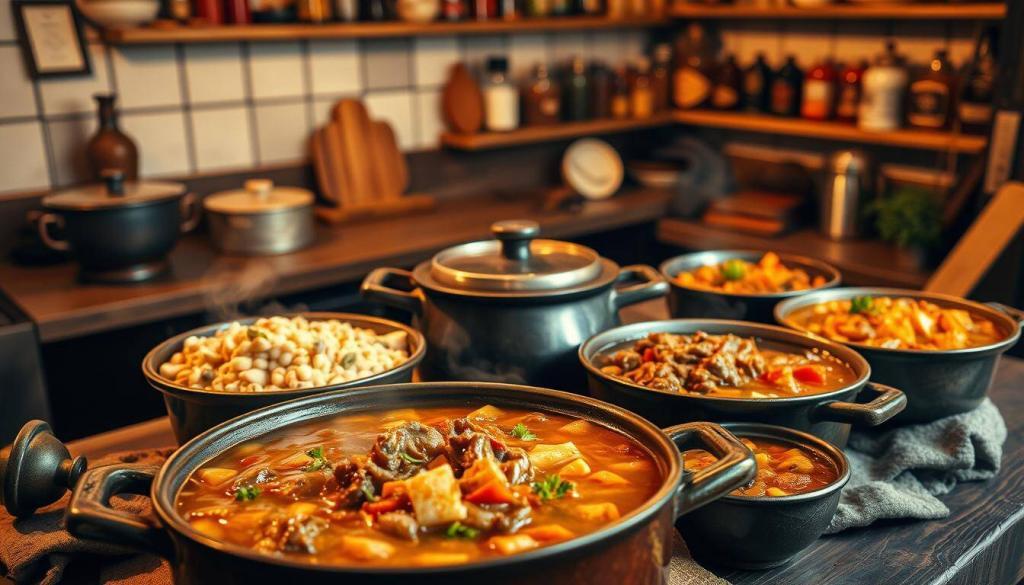
Adapting the Recipe with Local Irish Produce
One of the joys of cooking is experimenting with locally sourced ingredients. For instance, swapping out the traditional pork sausage for a spicier version can add a delightful kick. Similarly, using chicken broth instead of beer creates a lighter, yet equally flavourful base13.
Adding extra herbs like rosemary or sage can elevate the dish, while root vegetables like carrots and turnips bring additional depth. These small changes allow you to put your unique stamp on the recipe while staying true to its essence12.
Here are some ideas to inspire your own twist:
- Experiment with different types of sausages, such as chorizo or Cumberland.
- Use a mix of root vegetables for added texture and flavour.
- Replace beer with apple cider for a subtle sweetness.
Even slight adjustments can yield a uniquely delicious result. The key is to balance innovation with respect for the classic recipe. We’d love to hear about your adaptations—share your twists with us and keep the tradition alive!
Cultural Insights and Irish Culinary Traditions
The connection between food and culture is deeply rooted in tradition. Certain dishes transcend their role as sustenance to become symbols of identity and celebration. This is especially true for recipes that have been passed down through generations, carrying with them stories of heritage and community14.
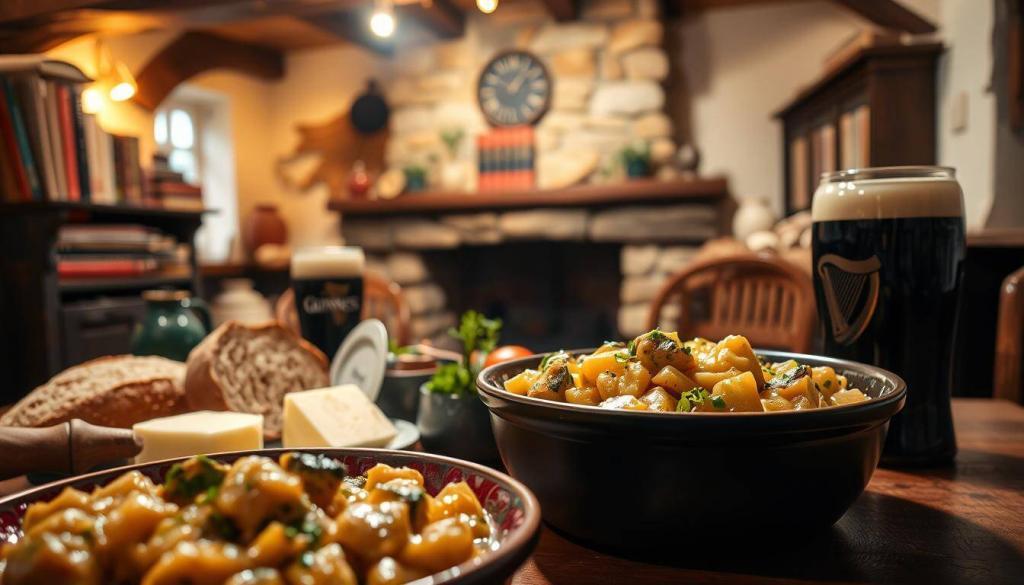
St Patrick’s Day and the Coddle Connection
St Patrick’s Day is a time when this dish takes centre stage. Its hearty ingredients, like sausage and bacon, make it a perfect fit for festive gatherings. The use of a dutch oven and precise layering techniques ensures the dish remains authentic and flavourful15.
Traditionally, a slice of soda bread is served on the side, complementing the rich flavours. This pairing highlights the dish’s role as a cultural emblem, bringing people together during celebrations14.
Reflections from Dublin’s Food Writers
Renowned food writers like Donal Skehan and Joan Scales have shared their thoughts on this classic recipe. They emphasise its simplicity and the importance of using quality ingredients, such as a large onion and a pound of sausages, to maintain authenticity15.
Chef John notes that the addition of black pepper and a cup of stout can elevate the dish, creating a robust flavour profile. These insights remind us that this recipe is more than just food—it’s a celebration of heritage14.
- Cultural Symbolism: The dish represents resilience and tradition.
- Festive Role: A staple during St Patrick’s Day celebrations.
- Expert Insights: Chefs and writers highlight its authenticity.
This dish continues to be a beloved part of Irish culinary heritage, offering warmth and connection with every serving. Its enduring legacy is a testament to the power of simple, hearty food15.
Troubleshooting and Perfecting Your Recipe
Perfecting a hearty stew requires attention to detail and a few expert tricks. Even the most seasoned cooks can encounter challenges, but with the right guidance, you can achieve a flawless result every time. Let’s explore common pitfalls and how to avoid them, ensuring your dish is balanced and delicious.
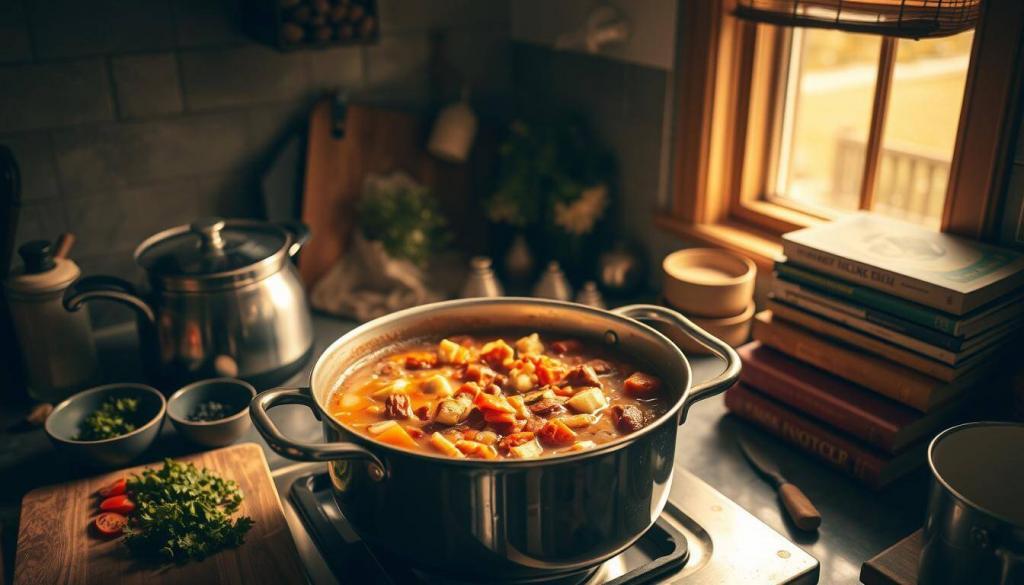
Common Pitfalls and How to Avoid Them
One of the most frequent issues is overcooking, which can lead to mushy potatoes. To prevent this, simmer the stew for no more than one hour and check the potatoes regularly16. Using waxy varieties like Maris Piper helps maintain their texture17.
Another challenge is overly rich fat from the bacon. To balance this, skim off excess fat before adding the broth. This ensures the dish remains hearty without being greasy18.
Seasoning is crucial. Too much pepper can overpower the dish, while too little leaves it bland. Add seasoning gradually, tasting as you go, to achieve the perfect balance16.
Tips for Enhanced Texture and Balanced Flavours
For a richer flavour, deglaze the pot with a cup of stout after browning the sausages. This adds depth and complexity to the gravy18.
Managing heat is key. Keep the stew at a gentle simmer to avoid overcooking. If using the oven, set it to 180°C (350°F) for even cooking16.
Here are some additional tips:
- Use a pound of high-quality pork sausages for optimal flavour.
- Cut ingredients into uniform pieces to ensure even cooking.
- Allow the stew to rest for a few minutes before serving to let the flavours meld.
With these techniques, you’ll master the art of creating a comforting, flavourful stew that’s perfect for any occasion.
Bringing the Warmth of Irish Dublin Coddle to Your Table
This hearty recipe is more than just a meal—it’s a celebration of tradition and togetherness. With simple ingredients like potatoes, bacon, and sausages, it’s a dish that brings comfort to any table. Whether you’re cooking for a family dinner or a festive gathering, it’s sure to warm hearts and fill bellies19.
Pair it with crusty soda bread and a fresh green salad for a complete meal. The rich broth and tender ingredients make it a standout dish that’s perfect for sharing. Using a dutch oven ensures even cooking and a depth of flavour that’s hard to beat20.
We encourage you to try this recipe and make it your own. Add your personal twist with herbs or root vegetables. Every step has been carefully explained to guide you to success. Share your results with us and become part of a culinary tradition that spans generations.
Source Links
- Meet Dublin Coddle: The Cozy Irish Stew That Warms the Soul – https://www.allrecipes.com/what-is-dublin-coddle-cozy-irish-stew-8601815
- Dublin Coddle Is the Soul-Warming Irish Stew Recipe You’ll Want to Save – https://www.allrecipes.com/how-to-make-dublin-coddle-8786282
- The History of Dublin Coddle: A Hearty Irish Tradition – https://kerrigans.ie/blogs/news/the-history-of-dublin-coddle-a-hearty-irish-tradition?srsltid=AfmBOoq8APVsLYOAjUWj3G2_m-ISc6wPwIcA7em8dnAHuYKV5UxQccap
- Coddle – https://en.wikipedia.org/wiki/Coddle
- How to make the perfect Dublin coddle – recipe | Felicity Cloake’s How to make the perfect … – https://www.theguardian.com/food/2023/nov/15/how-to-make-the-perfect-dublin-coddle-recipe-felicity-cloake
- Dublin Coddle Recipe (Irish Sausage and Potato Stew) | Wholefully – https://wholefully.com/dublin-coddle-7/
- Dublin Coddle – a Simply Fantastic Irish Stew | Kitchen Frau – https://www.kitchenfrau.com/dublin-coddle/
- How to Make Irish Coddle | Guided Recipes | Bacon By The Box – https://baconbythebox.com/blog/how-to-make-irish-coddle/
- A Dublin Coddle Is the Ultimate in Comfort Food – https://www.thespruceeats.com/dublin-coddle-recipe-p2-434877
- Your Step-By-Step Guide To Making A Deeply Flavorful Stock – https://www.yahoo.com/lifestyle/step-step-guide-making-deeply-121518100.html
- Recognizing food as part of Ireland’s intangible cultural heritage – https://www.academia.edu/62775613/Recognizing_food_as_part_of_Ireland_s_intangible_cultural_heritage
- Dublin Coddle Recipe & History – https://whatscookingamerica.net/soup/dublin-coddle.htm
- Uncover the Fascinating History of Ireland’s Favourite Stew – My Irish Trip – https://myirishtrip.com/uncover-the-fascinating-history-of-irelands-favourite-stew/
- Irish cuisine – https://en.wikipedia.org/wiki/Irish_cuisine
- Recognizing Food as Part of Ireland’s Intangible Cultural Heritage – https://arrow.tudublin.ie/cgi/viewcontent.cgi?article=1221&context=tfschafart
- Dublin Coddle Recipe – https://www.billyparisi.com/dublin-coddle/
- Slow Cooker Classic Dublin Coddle – Butcher Magazine – https://butchermagazine.com/slow-cooker-classic-dublin-coddle/
- The Best Coddle Recipe: A Rustic Irish One-Pot Stew – https://www.mrshappyhomemaker.com/dublin-coddle/
- Dublin Coddle Recipe (Irish Sausage and Potato Stew) – Olivia’s Cuisine – https://www.oliviascuisine.com/dublin-coddle/
- Craving A Warm and Gratifying Authentic Dublin Coddle? – https://notentirelyaverage.com/irish-coddle-recipe/
Footer 1
Call the HERD
Always available for any questions. Call and we will be happy to help.
Follow the HERD
Keep up to date on new products available in store.
Important Links
Join the HERD
Be the first to know about any offers or promotions.
- Herd Butchery 2025

Leave a Reply